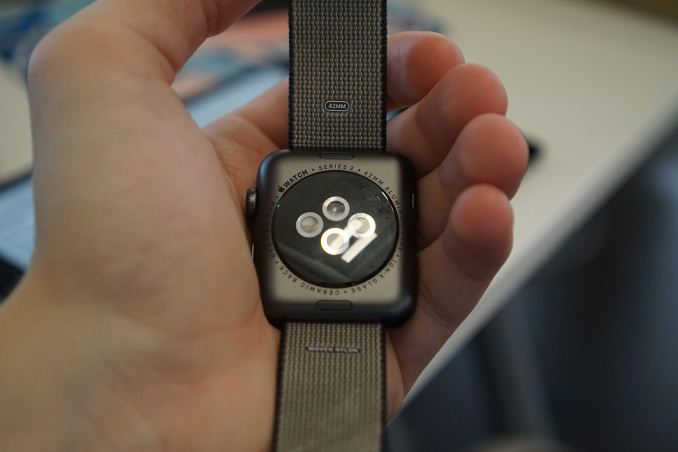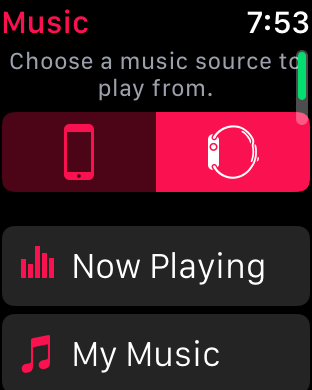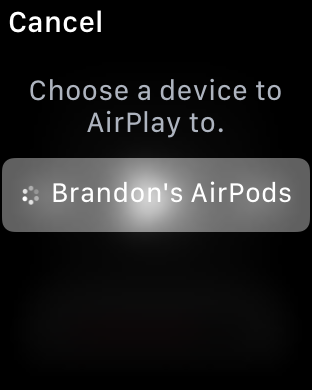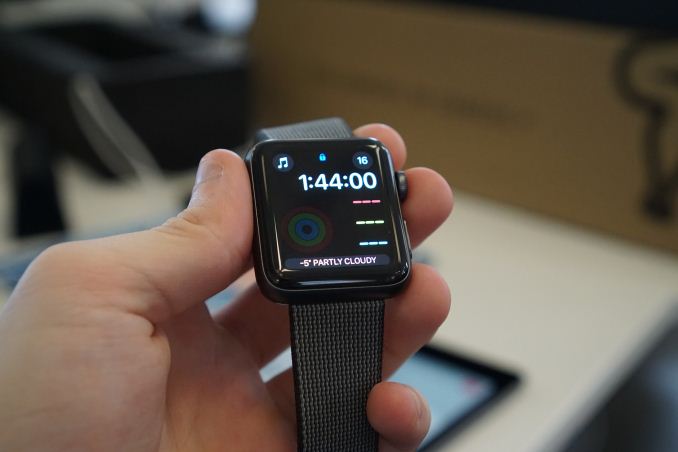The Apple Watch Series 2 Review: Building Towards Maturity
by Brandon Chester on December 20, 2016 8:00 AM EST- Posted in
- Wearables
- Apple
- Apple Watch
- Apple Watch Series 2
Final Words
In many industries, but especially in technology, there's a common wisdom about waiting for the second or third iteration of a product before purchasing it. This is based on the idea that the first version of a product will often be the most flawed or compromised - a product still trying to find its footing - and future iterations will benefit from improved technology, as well as fixes for flaws that were found in early versions. At the same time, there have to be some people who are adventurous enough to adopt bleeding-edge technology, or the first version of a product would simply fail in the market and there wouldn't ever be a second version.
This situation has played out for every iOS and iOS-derived device that Apple has created. The original iPhone was quite a technological marvel, but it was crippled by its lack of 3G networking, and its price was exceptionally high. With the iPhone 3G and 3GS, Apple addressed many of the issues that existed with the iPhone 2G, and by the time of the iPhone 4 the refinement was essentially at the same level that we expect from smartphones today. The original iPad was an interesting idea, but it was quick thick and heavy, and the hardware used at the time was not up to the task of powering such a device, sending it to end of life status after only two major updates. Only one year later, the iPad 2 addressed both of these issues, future versions brought faster hardware and higher resolution displays, and by the time of the iPad Air it reached a level of refinement where further versions have been much more iterative changes.
The first Apple Watch was definitely in the same situation as the iPhone 2G and the iPad 1. It was the first version of a brand new product, bound by serious hardware limitations and many unknowns about how consumers would come to use it. Like the iPad 1 it has received two major OS updates, and I don't expect it to go any farther. I talked earlier about how Apple had an idea of how the Apple Watch would be used, but clearly overestimated the appeal of some aspects and underestimated the appeal of others. The Apple Watch Series 2 focuses more on these aspects such as fitness with its GPS and true waterproofing, while watchOS 3 fixes many of the software issues that existed in the previous two versions.
The Apple Watch is still very much a companion to the iPhone. Even with the addition of GPS, it isn't close to being able to stand on its own. You can avoid bringing along the paired iPhone for workouts, and the watch can pull data from the network in some cases using its built in WiFi, but in general having the iPhone nearby is a requirement to actually do anything. Bringing cellular to the Watch would make it significantly less-dependent on the iPhone, but that also comes with a power and a space penalty, both of which are heavily constrained with a smartwatch.
Even if Apple were to bring cellular to the Apple Watch, I question how beneficial it would be for the experience given the two drawbacks I mentioned above. I can't think of many cases where I don't actually have my phone, so I don't know why I'd pay to maintain an additional cellular line for my watch when my phone was usually available to handle network activity. Additionally, adding cellular wouldn't remove the tight connection between the two devices, as the Apple Watch's settings and backups exist on the paired iPhone, and all of its applications are extensions of iPhone apps. This model makes it clear to me that Apple isn't planning to make the Apple Watch a standalone device any time soon.
As a companion to the iPhone, the Apple Watch works quite well. For me the Apple Watch is a timepiece, a hub for relevant information and notifications, a music player, and a health and fitness tracker. I've long since gotten used to having something on my wrist, and in fact I find myself checking my bare wrist out of habit when I've taken the Apple Watch off. Being able to check the time, the weather, the date, and other information simply by raising your wrist is just a convenience, and it's nothing your iPhone can't do as well, but it's a convenience that I wouldn't want to give up now that I have it.
Using Apple Watch as a music player is probably a more niche use case, but it does apply to me. It really seems like the natural replacement of the current iPod Nano, which is of a similar size. Of course, there's no headphone jack, but I've been using Bluetooth headphones for seven years so that doesn't present a problem for me personally. Even if you use your iPhone for music, the Apple Watch provides a quick way to access playback controls, especially if you have the Music application set as a complication or kept in the Dock. I suspect that more users will end up utilizing the standalone Music playback abilities of the Apple Watch now that the AirPods are shipping to consumers, but only time will tell.
Last, but not least, are the Apple Watch's health and fitness tracking abilities. When the Apple Watch first launched I thought I would just turn these off and forget about them, but my own poor health choices have led to me relying on them to keep myself on track. Having something constantly monitoring me is essential in figuring out how many calories I'm burning on a daily basis, which is how I decide what I'm going to eat. Workouts also provide me with various statistics about my jogging and cycling that I had always wondered about but had never been able to track. As the days get colder, having the Activity rings on the watch face is also a constant reminder that I need to keep active even if I'm staying inside to keep warm. Many of these things basically come down to the Apple Watch pointing out flaws in my personality that I won't improve of my own volition, and I'm okay with that because it produces results.
While I'm talking about the core aspects of the current Apple Watch experience, it does bear repeating that some things that Apple thought would be a big part of the experience have really fizzled out. I haven't found myself using it as a communication device except for taking phone calls, and Apple has de-emphasized communication as a feature in watchOS 3 accordingly, so I expect I wasn't alone. Similarly, I think issues with watchOS and the original Apple Watch's hardware have damaged the image of the Apple Watch as an app platform, and as someone who used the original I really haven't gotten used to using applications because in the past they just never worked.
As for development, I think it's fair to say that the Apple Watch hasn't yet proven itself as a developer platform. However, WatchKit is a really interesting and well thought out API for designing and developing apps for the smartwatch form factor. Despite the quality of the API itself, there's clearly still uncertainty over what an Apple Watch app should even aspire to do. I think not making a watchOS app at all is a valid decision for many iPhone applications, and that's an important decision for developers to make because it's an investment of time and money, and there are several applications that offer watchOS apps without any compelling functionality.
Ultimately, both watchOS and the Apple Watch are still in their early days, and the software will grow and improve over time as the hardware becomes faster and more efficient. The Apple Watch Series 2 really reminds me of the iPad 2. It tackles the areas where its predecessor faltered, and provides a much better experience as a result, but there's still that lingering early adopter feeling that even greater improvements are coming in the next generation. I would imagine that future series of the Apple Watch will bring additional sensors for tracking health information, thinner casings, and hopefully better battery life so features like sleep tracking will be possible. While there's always something to look forward to in future versions of a product, I think the Apple Watch Series 2 does provide a compelling experience right now, and for iPhone users interested in a fitness tracker or a smartwatch it should be high on your list of devices to consider.















126 Comments
View All Comments
mrvco - Friday, December 30, 2016 - link
I used an original iPhone and an iP4 and liked them very much. I've had a few iPads and still use a Mini2 and like it very much. The iWatch and smart watches in general still don't interest me. When I wear a watch, I prefer my mechanical automatic. Actually I'm surprised no one has developed a kinetic charging smart watch.yhselp - Tuesday, January 3, 2017 - link
I'd love to get one of those, but there's always something more important/practical to buy for that sort of money. I kind of wish it could drop to about $200 however unrealistic that may be. I was also hoping for an improvement to single-threaded performance courtesy of a new CPU.The original iPhone's two biggest drawbacks as I remember it were the lack of an app store for a full year (despite the vibrant homebrew scene) and its slowness. I remember trying a friend's iPhone 3G on cellular, and not finding it faster - the SoC was just not capable of loading pages fast. When I upgraded to the 3GS the difference was revelatory. Despite their drawbacks these were the two models I've had the most fun with - the App Store was an explosive hub for innovation, unlike the free-to-download money model of today, homebrew was huge, etc. The only thing I ever missed from my N82 was the camera.
The iPhone 3GS has to be *the* representative of the golden age of innovation for smartphones. Think about what Android handsets were back then. You can still use a 3GS today - I gave my old set to my s.o. when she had to replace the screen of her 6s; transferring her info from iCloud was seamless, and at first the 3GS was a bit of a shock for her, but after a day or so she came to grips with it and used the hell out of it for 10 days.
I kind of wish a similar boon of innovation would come to Apple Watch.
About sleep tracking: You would always have to charge a smart watch, even if it's once or twice a week, and the most practical time to do so would be when you're no using it, i.e. when you're sleeping. If they manage to implement a full charge that takes about 20 minutes and is safe to use in the long term, you could quickly charge your watch when you get back home from work, or when taking a shower.
richiwalt - Monday, January 9, 2017 - link
I have a question that's really puzzling to me: My series 1 is connected to my watch (and wifi is turned OFF on the phone). I leave my phone at my worstation ... and I begin to walk from one building to another, through an underground tunnel that connects the two building ... a distance of 265 feet. The watch connection breaks in the middle of the tunnel (about 150 feet from the phone) ... but when I proceed out the other side of the tunnel, the watch-phone connection is re-established. Both buildings share the same wifi SSID and password (but, remember ... wifi is turned off on the phone). So, how is the connection established from the watch to the phone on the other side of the tunnel. Not only my watch, but others in the building experience the same thing. Does the watch truly use bluetooth or wifi for a connection ? And, if wifi is turned off on the phone, how is that possible ? I'm really just wanting to understand this ...Deelron - Thursday, January 12, 2017 - link
Odds are this late you want see it (or it's moot) but what's likely happening is the watch is merely reconnecting to a wifi network your phone has been on before (not connecting to your phone, since it's wifi is off). The watch itself can do a decent amount of things on just wifi (like receive messages, make calls if the phone had wifi calling on at one point before, check the weather and use 3rd party apps that support wifi connectivity and the like).Aniklalani - Monday, July 3, 2017 - link
Brand new 24k Gold Finish Apple Digital Wrist I Watch A 42MM Aluminium Casing Projected.The Original Apple Box Includes Apple Watch,Magnetic Charging Cable,USB Power Adapter & Quick start Guide.-Make: Apple
-Model: MJ3Y2LL Stainless Steel Case with Milanese Loop
-Dimensions: Casae Width - 42 MM
-Material: Stainless Steel
-Material Fininsh: 24K Gold Plated
-Movenment: IOS Apple
-Band Material: Stainless Steel
-Band Color: Gold
-Other Details: Comes With Original Apple Box & Paper Work.
I bought this product from telemart .pk.Telemart offers you the best Apple Watch 42mm 24kt Gold Plated Price in Pakistan So what are you waiting for!
Hamm Burger - Saturday, November 4, 2017 - link
I'm amazingly late to this thread, but it's possible the blue bias in the color measurements is a result of Apple pre-calibrating to compensate for the blue pixels ageing faster than red and green.